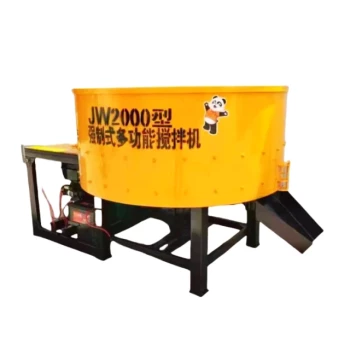A small cement mixer is a compact, portable device designed for mixing cement, mortar, or other construction materials efficiently. Its primary components include a rotating mixer bowl (or drum) where materials are blended, a motor (electric, gasoline, or hydraulic) to power the rotation, and a handle for manual control during pouring. These mixers are ideal for small-scale projects, offering ease of use and mobility. Additional features may include wheels for transport, a stand for stability, and sometimes a tilting mechanism for easier pouring. Understanding these components helps in selecting the right mixer for specific job requirements.
Key Points Explained:
-
Mixer Bowl/Drum
- The bowl or drum is the central component where cement, water, and aggregates are combined. It rotates to ensure thorough mixing.
- Materials: Typically made of durable steel or polyethylene to withstand abrasive materials.
- Capacity: Varies based on project size, with small mixers usually holding 1–6 cubic feet.
- Design: Some feature a tilting mechanism (cement mixer)[/topic/cement-mixer] for controlled pouring.
-
Motor or Power Source
- Drives the rotation of the bowl. Common types include:
- Electric motors: Quiet, low-maintenance, but require a power source.
- Gasoline engines: Portable but noisier and need fuel.
- Hydraulic systems: Used in heavy-duty models.
- Power ratings: Small mixers typically use 0.5–2 HP motors.
- Drives the rotation of the bowl. Common types include:
-
Handle and Maneuverability
- The handle allows operators to tilt or reposition the mixer for pouring.
- Ergonomics: Padded or adjustable handles improve user comfort.
- Additional mobility features: Wheels or a stand for stability and transport.
-
Optional Features
- Wheels: Enable easy movement around job sites.
- Stand/Legs: Provide stability during operation.
- Safety guards: Protect users from moving parts.
-
Applications and Selection Tips
- Best for small batches (e.g., DIY projects, repairs).
- Consider bowl material (steel for durability, polyethylene for corrosion resistance) and power source (electric for indoor use, gasoline for remote sites).
These components work together to deliver consistent mixing with minimal effort, making small cement mixers indispensable for tradespeople and homeowners alike. Have you considered how bowl size and power type might align with your project’s scale?
Summary Table:
| Component | Description | Key Features |
|---|---|---|
| Mixer Bowl/Drum | Rotating container for blending cement, water, and aggregates. | Durable steel/polyethylene, 1–6 cu ft capacity, tilting mechanism optional. |
| Motor/Power Source | Powers drum rotation (electric, gasoline, or hydraulic). | 0.5–2 HP; electric (quiet), gasoline (portable), hydraulic (heavy-duty). |
| Handle & Mobility | Tilts/repositions mixer; may include wheels/stand. | Ergonomic design, wheels for transport, stand for stability. |
| Optional Features | Enhances usability (e.g., safety guards, stands). | Improves safety and convenience on job sites. |
Upgrade your small-scale mixing projects with GARLWAY’s reliable cement mixers! Whether you’re a contractor tackling repairs or a DIY enthusiast, our portable electric cement mixers and compact batching plants deliver precision and durability. Contact us today to find the perfect mixer for your needs!
Products You Might Be Looking For:
Shop portable electric cement mixers for DIY projects
Explore small batch plants for efficient concrete production
Related Products
- Commercial Electric Concrete Mixer Machine HZS 50 Small Batch Plant for Sale
- HZS35 Small Cement Concrete Mixing Batch Plant
- Portable Electric Small Cement Mixer Concrete Machine
- JW1000 Mobile Cement Mixer Concrete Mixer Truck and Batching Plant
- Commercial Construction Mixer Machine for Soil Cement Mixing Concrete
People Also Ask
- What is the capacity of a small concrete mixer? Find the Perfect Size for Your Project
- How does a small cement mixer improve time efficiency? Boost Productivity on Your Job Site
- How does a small cement mixer save money? Cut Costs & Boost Efficiency
- How can small cement mixers be positioned or moved? Optimize Your Mixing Workflow
- How does a small cement mixer save time and effort? Boost Efficiency & Reduce Labor Strain



















